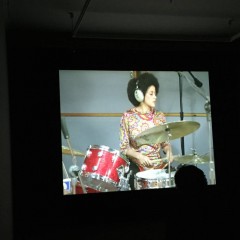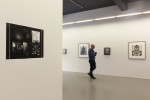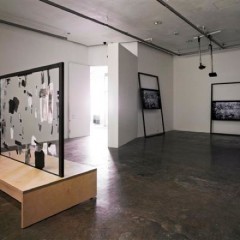It’s rare, but much more interesting, to find serious museums who are willing to take a focused look at art of particularly local interest rather than seeing yet again the same handful of artists who are fashionable at the moment throughout international art circles. I saw fascinating exhibits in July at The Dublin City Gallery The Hugh Lane and Project Arts Centre of two generations of artists whose themes are Irish national identity (not individual identity, as was of interest to Americans since the 1980s) during periods of change.
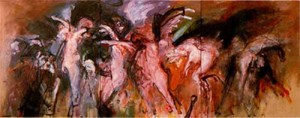
While much of the work would stand up to international viewing it all concerns specifically Irish questions that would require footnotes elsewhere.
The Quick and the Dead at the Hugh Lane (the title comes from the Apostle’s Creed: …and He shall come again, with glory, to judge both the quick and the dead, although in popular culture it’s associated with gun-fighting) looks at four artists who exhibited together in Dublin in the 1980s whose expressionist manner of painting set them off from the academic mainstream of Irish art: Patrick Graham, Brian McGuire, Patrick Hall and Timothy Hawkesworth. That the mainstream was isolated from international art, conservative, and perhaps a century out of date is certain; and the 80s saw a turn to expressionist painting internationally (Schnabel, Kiefer, Immendorf, Cucchi, Chia, Barcelo, …). But these four were motivated by discussions about the Irish state and the beginnings of a revisionist historiography. This idea needed some explication for an American, and fortunately I met a rather high government official who was able to explain that the revisionism in Irish intellectual circles meant questioning the fictions that make up the national myths characteristic of all states; Ireland’s myths were still young, as it only achieved independence from Britain in 1921.
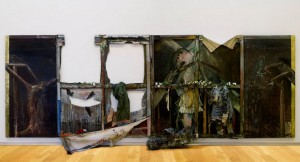
The exhibited work was from the 1980s to the present, but I’ll concentrate on the earlier paintings. Patrick Graham includes language within aggressively applied and re-worked paint to create images of pain and despair. His magnum opus, The Life and Death of Hoppalong Cassidy (a reference I do not understand), is a massive multi-part assemblage of multiple canvasses, some torn and hanging off their stretchers with various other appended objects. Among those objects are flowers, placed on a crossbar as if in memory of the figure behind who appears to be crucified. Or perhaps they are in memory of the construction of chicken-wire and detritus on the floor below; attached by a string to the painting it might be a human body or body fragment. The entire work resembles a war zone.
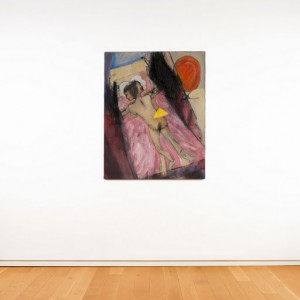
Lovelessness in Dublin (1983) by Brian McGuire depicts a couple engaged in sex on a bare bed beneath a hanging lamp. It speaks of poverty and disillusionment, while it’s human figures, both drawn and painted, resemble those of R.B. Kitaj. McGuire’s paintwork has become more lush but he continues to focus on the human figure. Patrick Hall’s monumental Flaying of Marsyas 2 (1984) refers to the Classical tale of an artist challenging the divine, and losing. Human figures appear to be floating through space so that their forms echo those of the landscape. The themes of landscape and death show up throughout Hall’s work; the round green form with a single eyeball in Seastone (2009) was likely inspired by Philip Guston’s late paintings, but sits on a definite horizon line.
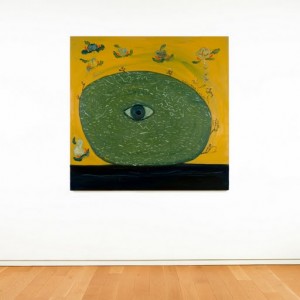
Timothy Hawksworth is the only one of the four whose later painting rejects representation, yet even his pure abstractions are visceral, inevitably evoking flesh. The Sower at Night triptych (1986) (see above) is another scene of death and violence underscored by its palette of red, black and white. Three figures appear to be crucified and horses are fleeing at right. This is in the grand tradition of history painting even if its drips and scumbles are thoroughly modern. It also has some of the abstracted horror of Francis Bacon’s work.
I was struck that the most obvious referent for all of the painters is one not mentioned in any of the catalog essays or artists’ statements: the School of London, particularly Kossof, Auerback, Bacon and Kitaj. These artists were a generation older than the four Irishmen and themselves significantly indebted to German Expressionism; it’s hard to believe their work was unknown in Dublin in the 1980s. I don’t know whether art politics is involved in the denial of influence and will refrain from trying to explain it. I will comment, however, that Irish expressionism seems to have been as exclusively a male movement as expressionism elsewhere and I’d like to know what kind of art their female colleagues were producing at the time. Perhaps sculpture, as was the case with the slightly younger artists Dorothy Cross, Kathy Prendergast and Alice Maher in their work of the late 80s.
The exhibition may have raised as many questions as it answered, but it was a very thoughtful view of recent Irish art history and an introduction to new work; I’m very grateful to have seen it and hope other museums will follow its example.
Questioning Nationalism in Contemporary Ireland
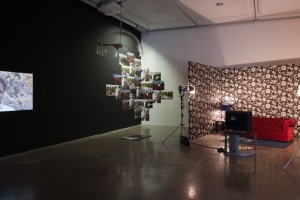
Project Arts Centre, Dublin paired with Belfast Exposed in Belfast to present parallel exhibitions by four artists titled The Prehistory of the Crisis (2), following Prehistory 1 at Project Art Centre in 2008, in which four European artists addressed immigration and nationalism. Until the 1990s and the economic boom termed the Celtic Tiger, Ireland’s main export had always been people. New economic wealth meant that for the first time Ireland needed and imported workers. The international economic collapse has left newly multi-cultural Ireland with an immigrant population and a faltering economy – often a recipe for social friction. Susanne Bosch, Anthony Haughey, Sinead McCann and Daniel Jewsbury created works about the complexity of a multi-cultural state and who and what is Irish in the 21st Century.
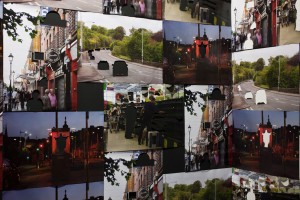
The works were of varied form (Bosch’s photographic posters to be taken away by the visitors, Haughey’s interactive installation with video, McCann’s installation and Jewesbury’s video narratives) and all of them open-ended and engaging the visitors who were asked again and again to put themselves in the places of others (or Others). Bosch (a German artist working in Belfast) displayed a montage of posters on the walls and offered them in piles on the floor. They showed scenes in Dublin and Belfast with the non-indigenous elements excised (literally cut-out of the paper), whether the foreign elements were tourists, automobiles, produce in a market or, in the case of No Other Jesus from Nazareth, a statue of an imported deity (with outspread arms, above). The resulting gaps were substantial and eloquent.
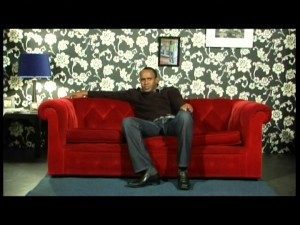
Haughey set up a living-room where the visitor could sit and watch videos shot within the same space in which both Irish and foreign nationals discussed the social confrontation. So I sat on the red couch and watched a woman from Ghana, attired in the wonderful polychrome of her homeland, sitting on the same couch. She said that the Irish had been hospitable at first, as in Ghana where custom demanded that foreigners be welcomed; but in contrast to Ireland, she said with subtle and humorous use of phrase, in Ghana “ it wasn’t politically correct” to ask visitors when they were planning to leave. Jewsbury’s video, Irish Lights, situated actors telling mis-matched narratives in front of the lighthouses built to protect Ireland; McCann’s installation, Interview, forced the viewer to crawl into an interrogation space and experience the position of the powerless individual confronting officialdom.
The exhibition was a timely and provocative study of Irish national identity and spoke in interesting dialog with the Hugh Lane exhibition.
Terry Winters Signal to Noise at the Irish Museum of Modern Art
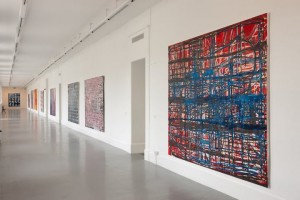
Signal to Noise at the Irish Museum of Modern Art (IMMA) surveyed the past decade of work by Terry Winters. The installation was stunning, opening with nine large paintings hung on one side of a long hall with windows opposite. They charted Winters’ interest in gridded structures, sequencing, technical models of sound and light, molecular forms and variations, and analogies between alphabets, architecture and other varied sequences of units. The smaller rooms behind the hall contained several large series of drawings and more paintings; their focused viewing made a successful contrast with the broad sweep of the opening gallery. It was a serious introduction of a significant American painter whose work had not previously been shown in Ireland.
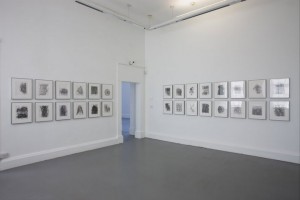
It was accompanied by a catalog, Terry Winters; Signal to Noise; Paintings and Drawings 1998-2008 (Charta, ISBN 978-88-8158-752-0) with handsome full-color illustrations of all the paintings and most of the drawings (although one series of 90 drawings is inexplicably printed in black and white on gray paper, reducing its detail). The texts, however, do the artist little credit. They are surprising in ignoring any discussion of the most obvious visual art analogy of the exhibition’s title, Signal to Noise. The scientific expression refers to a ratio of a sound or light signal to its surrounding interference. This is surely analogous to the figure/ground relationship which occupied the attention of so many 20th century artists; presumably a signal to noise ratio of one in painting would be a description of monochromes.
Enrique Juncosa’s essay is so filled with non-sequiturs and incomprehensible groupings of comparative artists that his statements on Winters are meaningless. For example: These artists [from the beginning of the 1970s], Dan Graham, Richard Serra, Marcel Broodthaers and James Coleman for example, are a reminder that it is impossible to reject the notion of subjectivity and in turn, that the viewer plays an important role in the interpretation of art. No further comment.
Peter Lamborn Wilson’s two essays indicate that his knowledge of art history is insufficient. He has an entire essay on knots which omits the most famous knots in Western art: those of Leonardo and Durer, which could well have illustrated his point. His first essay, a tendentious piece on hermeticism, devotes far too many pages to a screed against the omission of the subject in the history of art, science and pretty much everything else. He is apparently unaware of the catalog to LACMA’s 1986 exhibition The Spiritual in Art; Abstract Painting 1890-1985 with articles by 14 art historians on various forms of spirituality behind abstraction, other writing by those authors or any of their sources. He also seems ignorant of discussions of hermetic knowledge in writings on, to mention but a few, Runge, Kandinsky, Mondrian, Beuys, Polke, Al Jensen or Bruce Connor. Wilson is a poet and writer, which might excuse his oversights, but didn’t anyone at IMMA or the editor read the articles?


